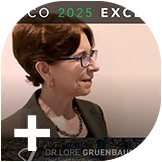ASCO25 reflections: Oncology’s evolution over the last decade and a new era on the horizon
Oncology has long set the pace for biomedical innovation, but the nature of that innovation is changing. The field is shifting from a decade built on sweeping breakthroughs to one defined by nuance, complexity, and increasingly demanding strategic decisions.
ASCO25 offered a glimpse of where the field is heading. For newer entrants, the challenge lies in carving out a place within an increasingly competitive landscape, shaped by biomarker-defined subgroups and combination strategies. Meeting these demands means generating strong data, building a clear and credible scientific story and understanding which patients will benefit and how diagnostics, treatment, and access must work together from the outset.
In this article, Sarah Reynolds, Director, Bioscript Group, reflects on insights from ASCO25. She explores the evolving story of oncology, looking back at what the last decade of PD-1/PDL1 therapies has taught us and forward to the opportunities and challenges presented by new approaches such as antibody-drug conjugates and cell therapies in solid tumours.
Checkpoint inhibition 10 years on
It was at ASCO over a decade ago that checkpoint inhibition captured the attention of the world. The initial data in melanoma marked a watershed moment in oncology, offering proof that long-term survival was possible in cancers once thought intractable. In the years that followed, PD-1/PDL1 therapies rapidly expanded into other solid tumours, becoming fundamental to modern cancer immunotherapy.
At ASCO25, it was clear just how deeply these agents have shaped the oncology landscape. Checkpoint inhibitors are now established across a vast array of tumour types and have helped drive a broader shift in how cancer is treated. One of the more recent evolutions for checkpoint inhibition is their role in the peri- and post-operative setting; at ASCO 2025 we heard the latest data for adjuvant nivolumab added to standard of care cisplatin-radiotherapy after surgery in HNSCC, which showed a meaningful survival improvement - the first strategy in over two decades to demonstrate superiority over standard of care in this patient group.
Meanwhile, an FDA win for pembrolizumab in the perioperative setting marks the first approval in HNSCC in six years and is the first perioperative treatment approved for locally advanced disease. Positioning the benefits of checkpoint inhibition in the peri/postoperative setting across various solid tumours will become a key area of highly competitive research over the coming years.
Looking to the future – big breakthroughs for the next decade
ADCs taking centre stage
ASCO25 reflected the depth of understanding gained over the past decade and the strategic sophistication now required to bring these therapies forward. As for the next decade of therapies, the ADC arena is rapidly becoming increasingly competitive. At ASCO, first-in-human data of FRα targeted LY4170156 showed a 55% overall response rate (ORR) in patients with advanced ovarian cancer, adding another potential candidate into the mix of FRα-ADCs alongside rinatabart sesutecan, the approved mirvetuximab soravtansine.
Other ADC highlights included phase I data on telisotuzumab adizutecan, a cMET-targeting ADC in third-line EGFR-mutated NSCLC that led to a 63% ORR; however, disappointing data in this population from HERTHENA-Lung02 study showed no survival benefit for patritumab deruxtecan, and led to two fatal cases of interstitial lung disease and a withdrawal of regulatory application. Balancing new toxicities with efficacy will be a key focus of refinement over the next decade as companies play with payload, linker, and targeting strategies in this fascinating class of therapeutics.
The evolution of cell therapy
While cell therapy has become well established in haematologic cancers, harnessing its potential in solid tumours has, until now, remained largely elusive. ASCO showed the first murmurings of new cell-based approaches; phase 2 from the C-144-01 trial data in advanced melanoma demonstrating long-lasting benefit with a one-time autologous tumour-infiltrating lymphocyte (TIL) cell therapy. CAR-T cell therapy also showed a 40% increase in survival in patients with advanced gastric or gastroesophageal junction cancer and in glioblastoma, a dual-target CAR-T cell therapy approach showed promise for slowing tumour growth, a notoriously aggressive brain cancer.
The developments in these areas speak to the growing potential of cell therapies to move beyond haematologic cancers. Yet, they also highlight the complexity involved. Regulatory expectations are evolving in parallel, particularly around long-term safety, delayed toxicities, and the need for sustained pharmacovigilance in personalised cell therapies. As highlighted at ASCO25, questions around appropriate endpoints, comparators, and risk mitigation are becoming more prominent, especially as traditional clinical frameworks are stretched by novel modalities.
This raises the bar for early decision-making. Cell therapy programmes must demonstrate biological potential, as well as define and defend a clear clinical position from the outset. That means identifying the right patient populations, anticipating regulatory scrutiny, and preparing to tell a scientifically credible, context-aware evidence story. In this context, precision in trial design, data strategy, and scientific communication will be essential to move from promise to practice.
The shifting clinical trial landscape
A consistent thread through the discussions at ASCO25 was the growing tension between the speed of innovation in oncology and the rigidity of traditional clinical trial frameworks. As therapeutic standards evolve rapidly, trial design is struggling to keep pace.
In response, we’re seeing increased use of “investigator’s choice” control arms as an attempt to reflect current clinical practice by allowing physicians to choose from an approved set of treatment options. While this approach can better reflect the diversity of real-world care, it also introduces variability that can complicate data interpretation and communication.
To address these challenges, sponsors are increasingly turning to supplementary strategies. Real-world evidence generation, indirect treatment comparisons, and meta-analyses across related trials can be used to strengthen the value proposition and support reimbursement discussions. However, these approaches can’t compensate for every design limitation, but when applied thoughtfully they help reinforce confidence in complex datasets.
For medical affairs and scientific communications teams, this reinforces the need to engage with strategic partners early in the development process, well before data readouts. Early involvement enables teams to anticipate where challenges may arise and supports more robust strategic planning.
This includes thinking ahead about what additional data may be needed to strengthen confidence in results, whether through real-world evidence, indirect comparisons, or clearly articulating the rationale behind study decisions. By contributing early, strategic partners can help shape a more resilient and context-aware narrative.
Clarity in complexity
ASCO25 offered a broad and detailed view of oncology’s trajectory by the sheer volume of sophisticated work underway across tumour types. The checkpoint inhibitor story, once revolutionary, is now entering a phase of refinement. Meanwhile, the emergence of new therapeutic approaches such as ADCs and cell therapy in solid tumours signals the beginning of another bold chapter, marked by scientific promise and operational complexity in equal measure.
Across both domains, the message is consistent: success depends on more than strong science. It requires early strategic thinking, well-considered trial design, and an ability to communicate not just what the data says, but why it matters. Differentiation now goes beyond efficacy and is about clarity, context, and the confidence with which you position your evidence.
As oncology continues to evolve, so must the approaches we take to define and defend innovation, because ultimately these decisions shape how quickly and effectively new treatments reach patients. Behind every trial, dataset, and regulatory milestone is a patient waiting for progress.
About the author
Sarah Reynolds, director at Bioscript Group, has extensive experience in medical communications and specialises in adapting to industry advancements. She leverages new tools and technologies, including AI, to enhance communication strategies, ensuring the industry remains at the forefront of innovation and effectiveness.
Supercharge your pharma insights: Sign up to pharmaphorum's newsletter for daily updates, weekly roundups, and in-depth analysis across all industry sectors.
Want to go deeper?
Continue your journey with these related reads from across pharmaphorum
Click on either of the images below for more articles from this edition of Deep Dive: AI 2024















